Apple Vision 2033: we can see the future
Did a world of Apple Vision turn out to be a utopia or a dystopia?

2033. Apple CEO Siri announces at WWDC33 that Apple has shipped its last iPhone a decade after the iPhone 15 appeared.
Siri adds: “And that’s great, because we’re all Apple Vision people now”. A bit too ominously for comfort, if everyone’s being honest. And ignoring the tiny point that Siri is not, in fact, ‘people’.
Anyway, members of the Apple faithful beam in having dutifully completed their transition from real screens to virtual spaces, eradicating anything in their homes that has a traditional display. TVs? Gone. iPhones and iPads? Gone. Apple Watch? Gone. Grandad’s CRT, which was somehow still running, so you could play on a games console from a time before what’s now referred to as the Great Dark Age of IAP? Sorry. That had to go too.
And that’s because Apple really did invent a world of spatial computing. (Well, someone else invented it. Apple later claimed it invented it, primarily by cunningly doing it better. And then everyone who scoffed at Apple having ‘invented’ it duly ripped Apple off, the second it was obvious Apple Vision would be a hit.) Virtual screens now exist all around us, whether we need them or not. And it’s a different world from what existed before – for better and worse.
StrappedToYourFaceTime
Back in 2023, there were doubts. Would people really strap an Apple Vision to their face all day? Didn’t the digital eyes on the front of the device look like a terrifying mix of Cronenberg and Pixar? Wasn’t it a bit weird that hardware initially pitched as the way to experience immersive movies had a battery that would conk out three quarters of the way through the latest entry in the MCU? And in a world of increasingly isolating digital experiences, would people really pay a huge chunk of change to isolate themselves still further?
The answers to those questions were, as it turned out, ‘yes’, ‘stop being weird’, ‘sigh’, and ‘you probably wouldn’t understand, because you are old’. Apple Vision Pro initially baffled in the same way the iPhone had baffled, and before it the Mac. It was a ‘step one’ people didn’t think we needed. Yet it upended lives in ways that weren’t initially apparent – especially when the rapidly evolving hardware dropped in price and heft, to the point it’s now more like a pair of swanky Ray-Bans that cost about as much as a typical 2020s smartphone.
Access all areas

Far from being isolating, Apple Vision helped people connect. Those with health conditions have been freed from a life within a window. They can be present with friends from all around the world, without leaving their homes. Events are more accessible. You can be at the game, without being at the game. Or go to Disney World without having to set foot in Florida. Which as of 2027 was just as well, because by then a third of it was underwater, a third of it was attempting to secede from the USA and rename itself Guntopia, and the other third was begging to be annexed by a sensible state.
The flip side is a lot of weirdness. People recording their entire lives in 3D. FakeEyes apps, to make it look like you’re paying attention to someone, when in reality you’re very much not. Digital personas that prove uncanny valley will forever be with us. Never being able to switch off. And a nagging feeling that although you are now more present in virtual worlds, something has been lost from the real one.
But then everything you really care about is now in spatial computing immersive environments, right? You don’t want for anything.
And that’s just as well, because with billions of people strapping screens to their faces 24/7, the average person on removing their Apple Vision, Samsung Eyes, Google Goggles, Microsoft HoloSpex, or Acer X67XWMMF-900s, can now barely see further than the end of their nose.
Now read: Apple Optic ID: what is it and how does it work?



